Related Research Articles

Saqqara, also spelled Sakkara or Saccara in English, is an Egyptian village in the markaz (county) of Badrashin in the Giza Governorate, that contains ancient burial grounds of Egyptian royalty, serving as the necropolis for the ancient Egyptian capital, Memphis. Saqqara contains numerous pyramids, including the Pyramid of Djoser, sometimes referred to as the Step Tomb, and a number of mastaba tombs. Located some 30 km (19 mi) south of modern-day Cairo, Saqqara covers an area of around 7 by 1.5 km.

Ubud is a town on the Indonesian island of Bali in Ubud District, located amongst rice paddies and steep ravines in the central foothills of the Gianyar regency. Promoted as an arts and culture centre, it has developed a large tourism industry. It forms a northern part of the Greater Denpasar metropolitan area.

The Capitoline Museums are a group of art and archaeological museums in Piazza del Campidoglio, on top of the Capitoline Hill in Rome, Italy. The historic seats of the museums are Palazzo dei Conservatori and Palazzo Nuovo, facing on the central trapezoidal piazza in a plan conceived by Michelangelo in 1536 and executed over a period of more than 400 years.
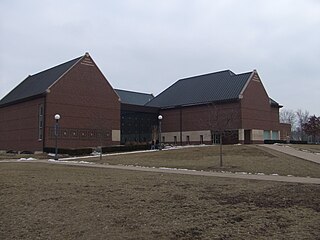
The William R. and Clarice V. Spurlock Museum, better known as the Spurlock Museum, is an ethnographic museum at the University of Illinois at Urbana-Champaign. The Spurlock Museum's permanent collection includes portions of collections from other museums and units on the Urbana-Champaign campus such as cultural artifacts from the Museum of Natural History and Department of Anthropology as well as historic clothing from the Bevier Collection of the College of Agricultural, Consumer and Environmental Sciences. The museum also holds objects donated by other institutions and private individuals. With approximately 51,000 objects in its artifact collection, the Spurlock Museum at the University of Illinois at Urbana-Champaign collects, preserves, documents, exhibits, and studies objects of cultural heritage. The museum's main galleries, highlighting the ancient Mediterranean, modern Africa, ancient Egypt, Mesopotamia, East Asia, Oceania, Europe, and the Americas, celebrate the diversity of cultures through time and across the globe.

Bangli Regency is the one and only landlocked regency (kabupaten) of Bali, Indonesia.

A candi is a Hindu or Buddhist temple in Indonesia, mostly built during the Zaman Hindu-Buddha or "Hindu-Buddhist period" between circa the 4th and 15th centuries.

The National Museum of Indonesia is an archeological, historical, ethnological, and geographical museum located in Jalan Medan Merdeka Barat, Central Jakarta, right on the west side of Merdeka Square. Popularly known as the Elephant Museum after the elephant statue in its forecourt, its broad collections cover all of Indonesia's territory and almost all of its history. The museum has endeavoured to preserve Indonesia's heritage for two centuries.
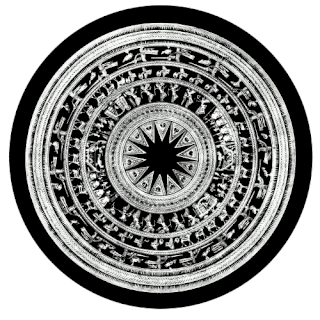
Bronze drums are ancient artifacts found in various cultures in Southeast Asia and southern China. The drums were cast in bronze using the lost-wax casting method. The drums were both musical instruments and cult objects. They are decorated with geometric patterns, scenes of daily life and war, animals and birds, and boats. Bronze drum is considered as one of the national symbols of Vietnam.

The Moon of Pejeng, also known as the Pejeng Moon, in Bali is the largest single-cast bronze kettle drum in the world. and "the largest known relic from Southeast Asia's Bronze Age period." It is "considered highly sacred by local people." It is thought to be a relic of early rice cultivation rituals.
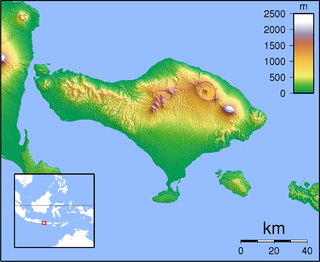
The History of Bali covers a period from the Paleolithic to the present, and is characterized by migrations of people and cultures from other parts of Asia. In the 16th century, the history of Bali started to be marked by Western influence with the arrival of Europeans, to become, after a long and difficult colonial period under the Dutch, an example of the preservation of traditional cultures and a key tourist destination.

Pura Ulun Danu Batur is a Hindu Balinese temple located on the island of Bali, Indonesia. As one of the Pura Kahyangan Jagat, Pura Ulun Danu Batur is one of the most important temples in Bali which acted as the maintainer of harmony and stability of the entire island. Pura Ulun Danu Batur represents the direction of the North and is dedicated to the god Vishnu and the local goddess Dewi Danu, goddess of Lake Batur, the largest lake in Bali. Following the destruction of the original temple compound, the temple was relocated and rebuilt in 1926. The temple, along with 3 other sites in Bali, form the Cultural Landscape of Bali Province which was inscribed as a World Heritage Site by UNESCO in 2012.
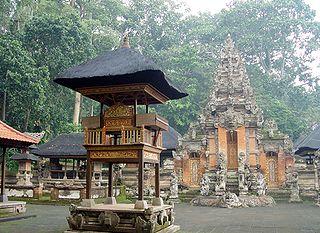
A Pura is a Balinese Hindu temple, and the place of worship for adherents of Balinese Hinduism in Indonesia. Puras are built following rules, style, guidance, and rituals found in Balinese architecture. Most puras are found on the island of Bali, where Hinduism is the predominant religion; however many puras exist in other parts of Indonesia where significant numbers of Balinese people reside. Mother Temple of Besakih is the most important, largest, and holiest temple in Bali. Many Puras have been built in Bali, leading it to be titled "the Island of a Thousand Puras".
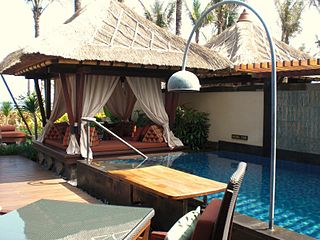
Balinese architecture is a vernacular architecture tradition of Balinese people that inhabits the volcanic island of Bali, Indonesia. Balinese architecture is a centuries-old architectural tradition influenced by Balinese culture developed from Hindu influences through ancient Javanese intermediary, as well as pre-Hindu elements of native Balinese architecture.

Pura Penataran Sasih is a Hindu temple in Pejeng village, Bali. According to a modern chronogram displayed at the entrance, it was founded in 1266 AD and served as the state temple of the Pejeng Kingdom.
Bedulu, also spelt Bedahulu or Bedaulu, is a historical site in Bali, Indonesia. It is situated about two kilometer to the west of today Gianyar town.

The Afyonkarahisar Archaeological Museum, also known as the Afyon Museum, is an archaeological museum in Afyonkarahisar, Turkey. It exhibits a wide variety of artifacts from the Copper Age, Bronze Age and the civilizations of Hittites, Phrygians, Ancient Greece and the Byzantine Empire.
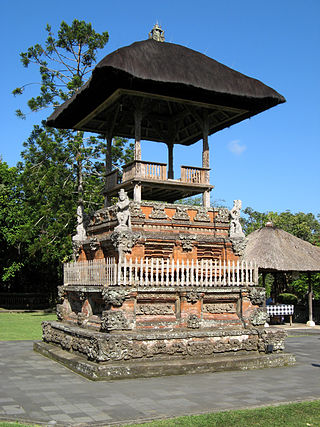
The bale kulkul or bale kul-kul is a Balinese pavilion where a slit-log drum is placed. It is essentially a drum tower or a watch tower. A bale kulkul can has a civic function, such as those used in villages as a mean of communication; or for religious function, an integral part of Balinese temple architecture.
Pura Griya Sakti is a Balinese Hindu temple located in the village of Manuaba, Kenderan administrative village, Tegalalang subdistrict, Gianyar Regency, Bali. The district is known for its woodcarving and its terraced rice field. The small village of Manuaba is about 4 km north of Kenderan or about 2.5 km southwest of the town of Tampaksiring with its famed Gunung Kawi temple. Pura Griya Sakti is the main temple of a powerful Brahman caste in the area.
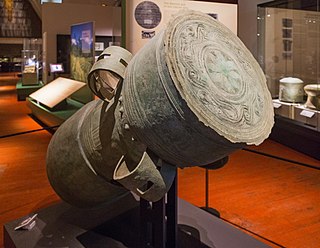
Pejeng drum is a type of Bronze Age kettledrum which was produced across the archipelago of Indonesia between the 1st and 2nd century AD. They are one of Indonesia's finest example of metalworking. Examples of Bronze Age Pejeng drum, such as the ancient Moon of Pejeng, is the largest bronze drum in the world, indicating the advance of metal casting technique and the active trade in the archipelago in the first millennium AD.

Pura Penataran Agung Lempuyang is a Balinese Hindu temple or pura located in the slope of Mount Lempuyang in Karangasem, Bali. Pura Penataran Agung Lempuyang is considered as part of a complex of pura surrounding Mount Lempuyang, one of the highly regarded temples of Bali. The temples of Mount Lempuyang, represented by the highest pura at the peak of Mount Lempuyang, Pura Lempuyang Luhur, is one of the Sad Kahyangan Jagad, or the "six sanctuaries of the world", the six holiest places of worship on Bali.
References
- 1 2 3 Gedong Arca Museum (1), bali.com.
- 1 2 3 4 5 Gedong Arca Museum (2), web.archive.org/blog.bali.
- ↑ "Itinenary from Penataran Sasih temple to Gedong Arca museum". google.fr/maps.